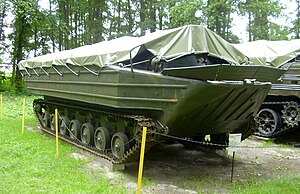K-61
| K-61 | |
|---|---|

A K-61 (2007) previously used by the Polish Army |
|
| General properties | |
| crew | 2 |
| length | 9150 mm |
| width | 3150 mm |
| height | 2150 mm |
| Dimensions | 9550 kg (empty weight) |
| agility | |
| drive | Six-cylinder diesel engine JaAS-206 (ЯАЗ-206) 133 kW (180 PS) |
| Top speed | 36 km / h |
| Power / weight | 13.8 kW / t (18.8 PS / t) |
| Range | 360 km (road) |
K-61 is the name of an all-terrain, unarmored amphibious vehicle . The vehicle, developed in the Soviet Union in the 1940s, was used in the Soviet Army and other armed forces to translate vehicles and technology over water hazards.
development
The experience of World War II had shown that armed forces needed ways to overcome water obstacles. Pontoon and other bridges had the advantage of great load-bearing capacity, but required a lot of time to erect and, for reasons of capacity, could not be erected over all water hazards. Bridge-laying tanks, on the other hand, were very mobile, but could only bridge narrow watercourses. With the BAW (БАВ), which was based on the design of the American DUKW , the Soviet Army had a translation tool at its disposal that could be relocated quickly and also overcome larger water obstacles. Inadequate was the low load capacity of 2.5 t, which was insufficient for the modern artillery and vehicles developed after the end of the war. The K-61 should fill this gap. With a decision of the Council of Ministers of the USSR on May 16, 1950, the vehicle was taken over into the armament of the Soviet Army. Series production also began in 1950 in the Krjukowski Waggon Building Plant (Крюковский вагоностроительный завод) in Kremenchug . In 1958, production was moved to the Stroimaschina plant in Izhevsk (Строймашина). Production was stopped in 1965.
construction
The water-tight welded tub is open at the top. In the bow are the places of the commander and the driver. The cargo area is also open at the top, but can be covered with a tarpaulin and bows. The tailgate can be folded down to make loading easier. A winch installed in the front of the vehicle can also be used for loading and unloading. It is driven by the drive motor. Two bilge pumps driven by a transfer case with a delivery rate of 400 l / min ensure that the vehicle can float in the event of damage.
The vehicle is powered by a water-cooled six-cylinder two-stroke diesel engine of the type JaAS-206 (ЯАЗ-206) from the Jaroslawski Motorny Sawod . This engine was used in various Soviet motor vehicles. With a displacement of 6981 cc he does in a built-up in the K-61 embodiment 180 hp at 2000 min -1 . The gearbox is driven with five forward gears via a single-disc dry clutch.
The chassis has seven rollers with torsion bars on each side. The chain is led through a support bar at the top. The drive wheel is at the front, the idler wheel, which is also used to tension the chain, is at the rear. In the water, the K-61 is powered by two water jets . The vehicle is steered in the water by two rudders, which are located in the jet of the propellers, and by changing the direction of rotation of the propellers.
The construction enables high performance and good maneuverability both on roads and in difficult terrain and on the water. The maximum speed on the road is 36 km / h, off-road at 25 km / h and on the water at 4.4 km / h. Use in water is permitted up to a flow velocity of 2.5 m / s. The maximum payload on land is 3000 kg and on water 5000 kg. Obstacles up to a height of 650 mm can be exceeded, the climbing ability is 46.5%. The K-61 can carry a fully operated gun, a light truck, or up to 40 soldiers.
commitment
In the Soviet Army, the K-61 was used in the translation companies (переправочная-десантная рота) of the engineer battalions (инженерно-саперный батальон). Such a company with nine vehicles existed per division. Each army also had an independent translation battalion (отдельный переправочно-десантный батальон), which had two translation companies with 36 vehicles. In armed forces based on the Soviet model, the translation forces equipped with K-61 were structured similarly. From 1973 the K-61 was replaced in the Soviet Army by the PTS-2 , which can carry twice the payload.
In the National People's Army (NVA) the K-61 was used from 1964. A total of 85 vehicles are said to have been procured. In the NVA, the K-61 was also known as the large floating car K-61 , the full chain floating vehicle K-61 and the floating chain transport vehicle K-61 .
Individual evidence
- ↑ Information according to DV 17/5
Web links
literature
- Wilfried Copenhagen: The land forces of the NVA . Motorbuch Verlag, Stuttgart 2003, ISBN 3-613-02297-4 .
